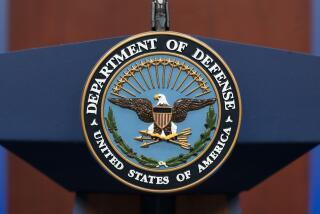Carrier Group Move Routine, Pentagon Says
WASHINGTON — The Navy, with the routine deployment of a carrier battle group into the Mediterranean Sea, has forces in place to launch a retaliatory strike against Libya, Pentagon sources said Friday.
But President Reagan has made no decision to proceed with any type of military response to the Dec. 27 terrorist attacks on the Rome and Vienna airports, and any such mission would be fraught with difficulty and danger, said Pentagon officials who spoke on condition that they would not be identified.
Reagan, posing for pictures in Mexicali, Mexico, with Mexican President Miguel de la Madrid, was asked about reports of U.S. military movements in the Mediterranean.
“I’m not aware that we’re doing anything out of the ordinary at all,” he said.
President’s Reply
Asked whether a buildup of U.S. forces was under way, Reagan said, “You’ve got to stop listening to Kadafi,” a reference to Libyan leader Moammar Kadafi, who has accused the United States of aggressive intentions.
The State Department, which for years has been telling Americans to stay out of Libya, said its ability to aid those who ignored the warnings would be nearly “non-existent” if the current tensions lead to anti-American action. Between 1,000 and 1,500 U.S. citizens, many of them dependents of Libyans or employed by Libyan or third-country business, are in Libya.
“Our policy always is to do what we can for American citizens,” said department spokesman Charles E. Redman. “We try to make it as clear as we can that when you go to places where we have no diplomatic representation that our ability to assist American citizens under such circumstances would be severely limited if not non-existent.”
The United States repeated its four-year old warning against travel to Libya last week after accusing the Kadafi government of supporting the Palestinian group blamed for the airport raids.
‘Make My Day’
At the Pentagon, one official, stressing the hazards of an American military operation, said of the Libyans: “They’re just sitting there saying, ‘Make my day.’ There would be no surprise. They’re sitting there on alert.”
The sources noted Libya has a wide range of sophisticated weapons, including Soviet-made fighters and surface-to-air missiles as well as coastal patrol boats, a half-dozen diesel-powered submarines and anti-aircraft guns and radars.
The United States lost two warplanes in December, 1983, when it carried out retaliatory air strikes in Libya.
The Pentagon sources said an aircraft carrier battle group in Norfolk, Va., had been told to make initial preparations for an unscheduled deployment to the Mediterranean. They identified the carrier America as the recipient of the order. There were indications that Navy contingency plans might include a similar order for the battleship Iowa.
‘No Order to Deploy’
“There has been no order to deploy,” one source said. “They have been notified to make prudent preparations. If there is going to be a long-term terrorist threat, it might make sense to have two carriers instead of one in the Med.”
Once dispatched, the America and her group would require about 10 days to make the Atlantic passage.
On Wednesday, Kadafi vowed a “never-ending war” if “an aggression on Libya occurs.” Libya sent its ships to sea on Thursday and ordered its forces on alert.
U.S. and Israeli officials have begun exploring military, economic and diplomatic sanctions against Libya because they believe a Palestinian faction headed by PLO renegade Abu Nidal, said to be based in Libya, was responsible for the airport attacks.
A Routine Action
On Friday, in what Navy officials went to pains to describe as a routine action, the carrier Coral Sea and her battle group ended a holiday port leave in Italy and steamed into the central Mediterranean. Sources said the group includes two cruisers, two destroyers and two frigates in addition to the Coral Sea.
The carrier left Naples with a small group of Italian journalists on board for a one-day tour, suggesting that there were no immediate plans to launch an air strike.
Other sources said, however, that a small number of combat planes had been dispatched from the United States to the Mediterranean region to ensure that the Coral Sea’s air wing is at full strength. One source said the carrier is equipped with four squadrons of F-A-18 fighters, one squadron of A-6 attack bombers and several E2-C Hawkeye radar planes. Each squadron has roughly a dozen planes.
Officials in the Defense Department cited a host of sticky military and political problems that would be involved in a strike against Libya. Beyond the military problems of knocking out radar and missile sites as well as Libyan fighters, one source cited fears for the safety of Americans inside Libya and the ramifications of an attack if Soviet advisers were killed.
“On the other hand, you can only bluster so long with threats of retaliation before you have to do something,” another source said.
More to Read
Sign up for Essential California
The most important California stories and recommendations in your inbox every morning.
You may occasionally receive promotional content from the Los Angeles Times.










